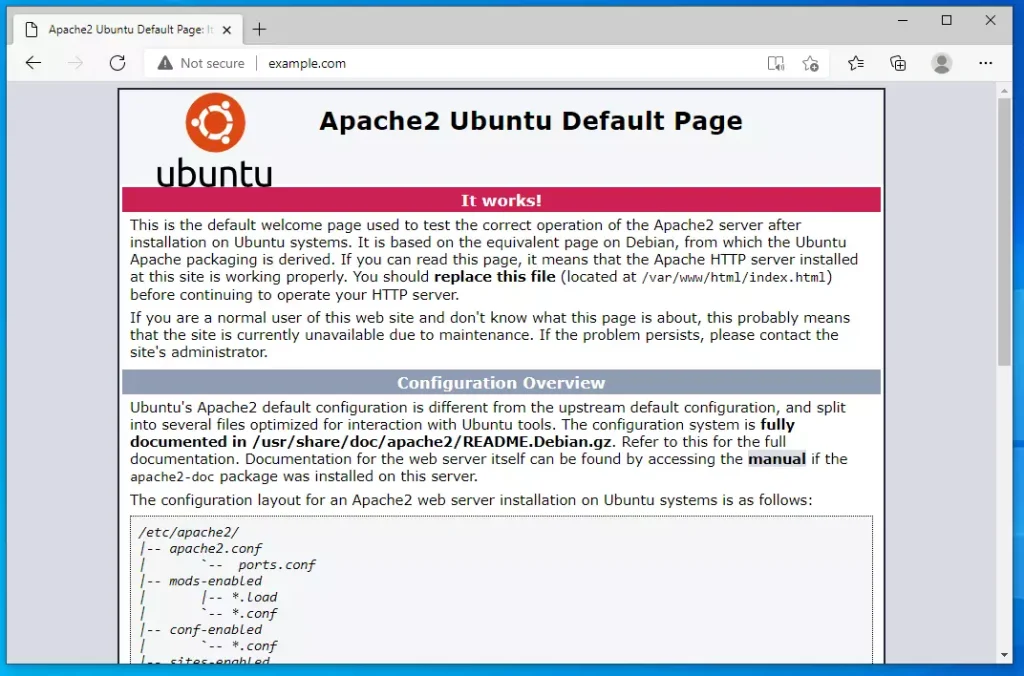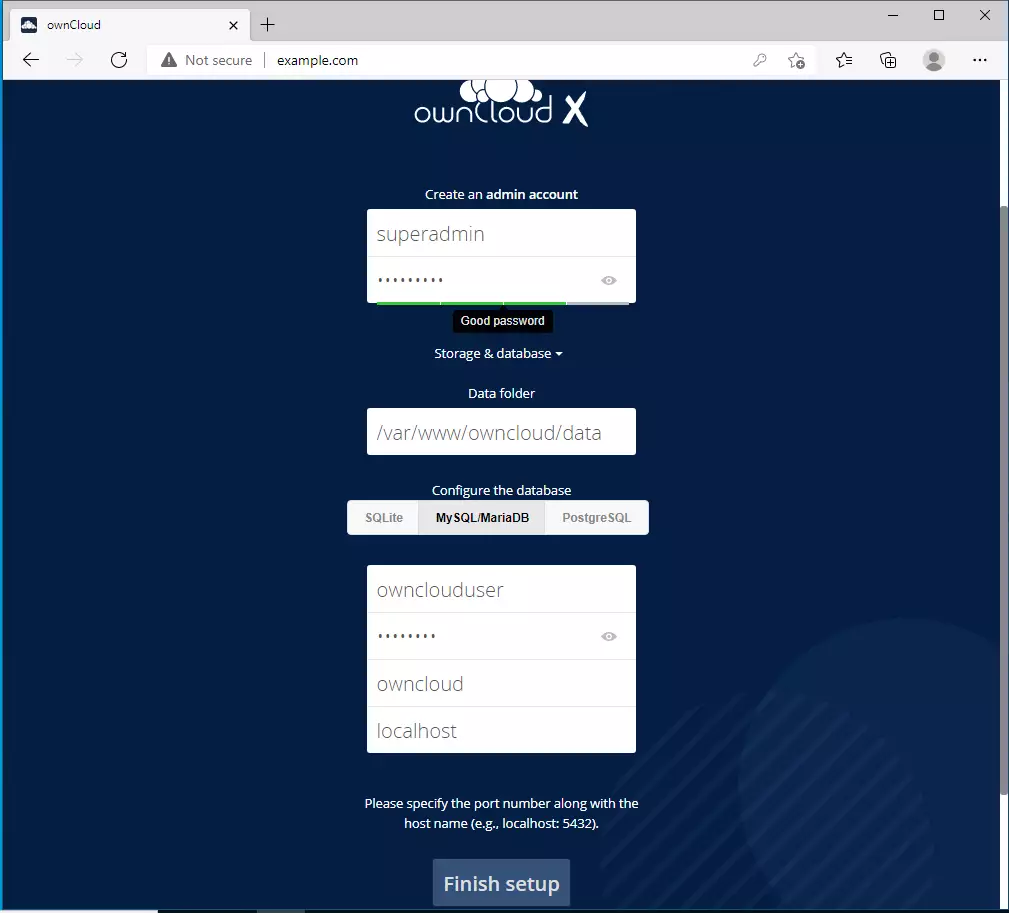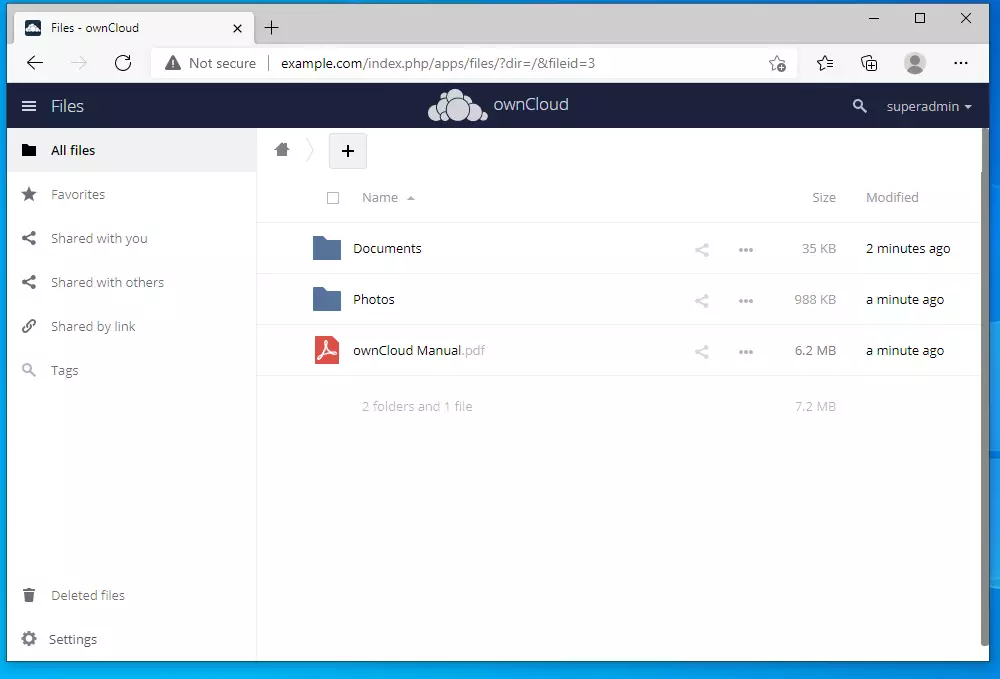This brief tutorial shows students and new users how to install ownCloud with Apache on Windows 10 WSL (Windows Subsystem for Linux) 2 with Ubuntu OS.
ownCloud is an open-source, self-hosted file-syncing and sharing platform similar to Dropbox, OneDrive, and Google Drive. It lets you create your cloud in your environment with your servers.
Installing your ownCloud on Windows WSL allows you to run a self-hosted file-syncing and sharing platform in your local environment. It’s an excellent option for those who want to create their cloud in their environment with their servers.
WSL allows you to install and run a complete Linux operating system inside Windows, meaning you can run your Cloud on Windows without needing a separate server.
Additionally, WSL 2 comes with a performance boost and complete system call compatibility, making it a fantastic way to run a Linux environment in Windows.
If you have a machine that meets the requirements above to run WSL 2, continue below.
To get started with running ownCloud on Windows with WSL, follow the steps below:
Enable WSL in Windows
To enable WSL in Windows, you will need to open the PowerShell terminal as an administrator. Click on Start, then begin typing PowerShell.
Next, right-click the Windows PowerShell app and choose to run as administrator.

When the console opens, run the commands below:
dism.exe /online /enable-feature /featurename:Microsoft-Windows-Subsystem-Linux /all /norestart
After installing, you should get a success message similar to the lines below:
Deployment Image Servicing and Management tool Version: 10.0.19041.844 Image Version: 10.0.19042.844 Enabling feature(s) [==========================100.0%==========================] The operation completed successfully.
Enable Virtual Machine Platform
WSL 2 requires Windows 10 Virtual Machine Platform to be enabled. This is not Hyper-V. To allow the VM to platform feature in Windows, run the commands below from the same PowerShell administrator’s console.
dism.exe /online /enable-feature /featurename:VirtualMachinePlatform /all /norestart
If you’re using Windows 10 version lower than 2004, then use the commands below:
Enable-WindowsOptionalFeature -Online -FeatureName VirtualMachinePlatform -NoRestart
When you’re done running the commands above, restart your computer for all the configuration changes to apply. If you don’t restart, the below command might not be recognized.
After restarting your computer, log back in and launch PowerShell as administrator. Then, run the commands below to configure WSL 2 as the default version of WSL.
wsl --set-default-version 2
Install Ubuntu on Windows 11
Now that WSL 2 is installed and ready to be used, open the link below to download and install a copy of Ubuntu 20.04 from the Windows store.
Get Ubuntu 20.04 LTS – Microsoft Store
Ubuntu 20.04 LTS on Windows allows you to use Ubuntu Terminal and run Ubuntu command line utilities, including bash, ssh, git, apt, and many more.

Click the Get button and install. After installing Ubuntu, you’ll want the option to launch Ubuntu from the Windows WSL environment.
After launching, Ubuntu should install and prompt you to create your account.
Installing, this may take a few minutes.
Please create a default UNIX user account. The username does not need to match your Windows username.
For more information visit: https://aka.ms/wslusers
Enter new UNIX username: richard
New password:
Retype new password:
passwd: password updated successfully
Installation successful!
To run a command as administrator (user "root"), use "sudo <command>".
See "man sudo_root" for details.
Welcome to Ubuntu 20.04.2 LTS (GNU/Linux 4.4.0-19041-Microsoft x86_64)
* Documentation: https://help.ubuntu.com
* Management: https://landscape.canonical.com
* Support: https://ubuntu.com/advantage
System information as of Mon Apr 12 17:57:37 CDT 2021
System load: 0.52 Processes: 7
Usage of /home: unknown Users logged in: 0
Memory usage: 26% IPv4 address for eth0: 10.0.2.15
Swap usage: 0%
1 update can be installed immediately.
0 of these updates are security updates.
To see these additional updates run: apt list --upgradable
That should do it!
Some troubleshooting commands to run when you run into the issues above. These run below and try to relaunch the Ubuntu image.
wsl --set-default-version 1 bcdedit /set hypervisorlaunchtype auto start
Now that the Windows 10 WSL environment is ready, continue to install Apache, MariaDB, and PHP and configure your ownCloud.
Install Apache HTTP Server
Apache is the most popular open-source web server powering most websites online. Since ownCloud needs it, use the commands below to install it on Ubuntu.
To install Apache on Ubuntu, run the commands below:
sudo apt update sudo apt install apache2
After installing Apache2, the commands below can be used to stop, start and restart Apache2 services.
sudo service apache2 stop sudo service apache2 start sudo service apache2 restart
To validate that Apache is installed and functioning, open your web browser and browse to the server’s hostname or IP address.
You should get a test page if everything works.
http://localhost

Install MariaDB Database Server
For this tutorial, we’re going to be installing MariaDB. ownCloud needs a database server to store its content.
MariaDB is a truly open-source database server you can run with your projects. It is fast, secure, and the default server for almost all Linux.
To install MariaDB, run the commands below:
sudo apt-get install mariadb-server mariadb-client
After installing MariaDB, the commands below can be used to stop, start, and restart MariaDB services.
sudo service mysql stop sudo service mysql start sudo service mysql restart
Next, run the commands below to secure the database server with a root password if you were not prompted to do so during the installation.
sudo mysql_secure_installation
When prompted, answer the questions below by following the guide.
- Enter current password for root (enter for none): Just press the Enter
- Set root password? [Y/n]: Y
- New password: Enter password
- Re-enter new password: Repeat password
- Remove anonymous users? [Y/n]: Y
- Disallow root login remotely? [Y/n]: Y
- Remove test database and access to it? [Y/n]: Y
- Reload privilege tables now? [Y/n]: Y
To verify and validate that MariaDB is installed and working, log in to the database console using the commands below:
sudo mysql -u root -p
Type the root password when prompted.
Welcome to the MariaDB monitor. Commands end with ; or \g.
Your MariaDB connection id is 46
Server version: 10.3.29-MariaDB-0ubuntu0.20.04.1 Ubuntu 20.04
Copyright (c) 2000, 2018, Oracle, MariaDB Corporation Ab and others.
Type 'help;' or '\h' for help. Type '\c' to clear the current input statement.
MariaDB [(none)]>
The server was successfully installed if you see a similar screen.
Install PHP and Related Modules
PHP is a general-purpose scripting language that glues all the above components together. ownCloud is a PHP application and requires PHP and related modules to function.
To install PHP and recommended modules, run the commands below.
sudo apt install php libapache2-mod-php php-imagick php-imap php-json php-ldap php-common php-pgsql php-ssh2 php-sqlite3 php-xml php-mysql php-gmp php-curl php-intl php7.4-mbstring php-xmlrpc php-gd php-xml php-cli php-zip
That should get PHP installed with recommended PHP modules that you can run with many PHP-based applications.
To validate that PHP is installed, run the commands below:
php -v
You should see an output like the one below:
PHP 7.4.3 (cli) (built: Oct 6 2020 15:47:56) ( NTS ) Copyright (c) The PHP Group Zend Engine v3.4.0, Copyright (c) Zend Technologies with Zend OPcache v7.4.3, Copyright (c), by Zend Technologies
You can also test with a test PHP script and display the installed version and related modules that are enabled or disabled.
To do that, run the commands below to create a PHP test file called phpinfo.php
sudo nano /var/www/html/phpinfo.php
Then, type the content below and save the file.
<?php phpinfo( ); ?>
Save the file.
Open your browser and browse to your server hostname followed by phpinfo.php
Restart Apache, then type the address and browse the file.
http://example.com/phpinfo.php
You should see the PHP default test page.

At this stage, all required components that ownCloud needs are installed above. Continue below to download and configure your Cloud settings.
Create ownCloud Database
Now that you’ve installed all the packages required for OwnCloud to function continue below to start configuring the servers. First, run the commands below to create a blank OwnCloud database.
To log on to the MariaDB database server, run the commands below.
sudo mysql -u root -p
Then, create a database called owncloud
CREATE DATABASE owncloud;
Create a database user called ownclouduser with a new password
CREATE USER 'ownclouduser'@'localhost' IDENTIFIED BY 'new_password_here';
Then, grant the user full access to the Database.
GRANT ALL ON owncloud.* TO 'ownclouduser'@'localhost' WITH GRANT OPTION;
Finally, save your changes and exit.
FLUSH PRIVILEGES; EXIT;
Download ownCloud
Next, download the latest version of ownCloud.
When writing this article, the latest stable version of ownCloud is version 10.7. Before continuing with the next step, visit the ownCloud download page and check if a new version of ownCloud is available.
wget https://download.owncloud.org/community/owncloud-complete-20210326.zip -P /tmp sudo unzip /tmp/owncloud-complete-20210326.zip -d /var/www
Then, run the commands below to set the correct permissions for OwnCloud to function.
sudo chown -R www-data:www-data /var/www/owncloud/ sudo chmod -R 755 /var/www/owncloud/
Configure ownCloud Site
Finally, configure the Apahce2 site configuration file for OwnCloud. This file will control how users access OwnCloud content. Run the commands below to create a new configuration file called owncloud. conf
sudo nano /etc/apache2/sites-available/owncloud.conf
Then copy and paste the content below into the file and save it. Replace the highlighted line with your domain name and directory root location.
<VirtualHost *:80>
ServerAdmin admin@example.com
DocumentRoot /var/www/owncloud/
ServerName example.com
ServerAlias www.example.com
Alias /owncloud "/var/www/owncloud/"
<Directory /var/www/owncloud/>
Options +FollowSymlinks
AllowOverride All
Require all granted
<IfModule mod_dav.c>
Dav off
</IfModule>
SetEnv HOME /var/www/owncloud
SetEnv HTTP_HOME /var/www/owncloud
</Directory>
ErrorLog ${APACHE_LOG_DIR}/error.log
CustomLog ${APACHE_LOG_DIR}/access.log combined
</VirtualHost>
Save the file and exit.
After configuring the VirtualHost above, please enable it by running the commands below, including other modules.
sudo a2ensite owncloud.conf sudo a2enmod rewrite sudo a2enmod headers sudo a2enmod env sudo a2enmod dir sudo a2enmod mime
When you’re done, restart Apache.
sudo service apache2 restart
Now browse the server hostname or IP address and set up your Cloud platform.
http://example.com
Create an admin account, enter the database details, and finish the installation.

Log in with the account you create above and start building your environment.

Conclusion:
This post showed you how to install your Cloud in Windows WSL. If you find any error above, please use the comment form below to report.

Leave a Reply Cancel reply